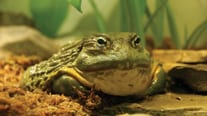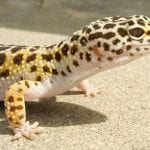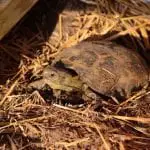Amphibians are currently facing a massive extinction crisis. Over 160 species of the amphibians might be extinct already. Over 1,800 amphibians have been found vulnerable to extinction. That is 32 percent of the known amphibian species. At least 43% of the species have undergone the population declines, while less than 1% show increases in the population.
The biggest threat that amphibians face is degradation and habitat loss. Other substantial threats involve climate change, pollution, overcollection, and introduced species. Maybe, the most disturbing risk is the newly recognized fungal infection that triggers fast and severe amphibian deterioration.
What’s being done to assist amphibians? As the initial step, more experts contribute to the Global Amphibian Assessment, which is a continuous project that manages the distribution as well as the conservation status of the known species. Amphibian experts across the globe work on understanding the possible cause of the declines, develop a long-term conservation program, and respond to an immediate crisis.
Amphibians referred to as the canaries within the worldwide coalmine and nature’s indicators since they’re some of the living things that can suffer from the environmental changes. When amphibians show the decline, it will serve as the caution to other species, which include humans. By helping amphibians, everyone is helping the world.
Top 12 Amphibians Saved by Zoos
#1. African Bullfrog
While the African bullfrogs aren’t threatened or endangered, they might be decreasing in numbers due to habitat destruction, hunting, and collection of the pet trade. The African bullfrog is the biggest amphibian situated in South Africa.
The frog comes with the ability to tolerate the harsh environment in Africa. The temperature can increase to more than 100 degrees Fahrenheit and drop below the freezing point during winter. At this period, the bullfrog stays underground and wait for the upcoming rainy season.
#2. Dyeing Poison Dart Frog
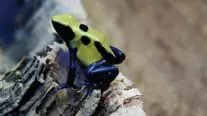
This frog is under threat from the development of its habitat and overcollection for the pet trade. Their biggest predator is humans. They protect themselves against predation by using their poisonous skin secretions and coloration.
The dyeing poison dart frog is bright-colored and can be found in many different patterns and colors like yellow, black, and sapphire blue. These bright colors will serve as warnings to predators, indicating that this frog is toxic. Also, the skin of this frog is wrapped into deadly alkaloid poisons, which can kill or paralyze the predators.
#3. Oriental Fire-bellied Toad
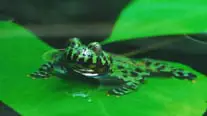
The main threat to the survival of fire-bellied toads is the loss of habitat, which is why the Oriental Fire-Bellied Toad is on the list of threatened species. Other threats involve a change of the habitat, pollution, draining of the swamps, and diseases.
The oriental fire-bellied toad comes in bright green to dull brown shade on the back, which is typically dotted with the black spots. The belly of this frog is either orange-red or red. It also has a small, rounded head and big eyes with the heart-shaped pupils. The skin of its dorsal side has been covered with tiny tubercles. The pupils of this frog are sometimes triangular-shaped.
When the oriental fire-bellied toad detects danger, it will arch its body and flash the bright warning spots on the belly. It might flip itself to show its colors. It holds that pose until the predator gets the message and back off.
These colorings on the frog’s skin serve as the warning to the predators regarding how toxic the frog can be. The toad will produce the toxin only if the predators pursue it. The toxin is a milky-like substance that the toad releases whenever it feels frightened or disturbed. The toxin has been secreted over the skin, typically through its hind legs and belly in some cases.
#4. Panamanian Golden Frog
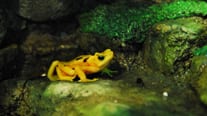
The Panamanian Golden Frog might be critically endangered and extinct within the forest. While the international amphibian crisis is due to habitat loss, pollution, and climate change, the life-threatening chytrid fungus has a big role in the decreasing population of these frog and other species.
The Panamanian golden frog lives in the streams alongside the mountainous slopes in the Cordilleran cloud woodlands in west-central Panama. As the IUCN listed it as a critically endangered species, the Panamanian golden frog might be extinct in the forest since 2007. People collected this frog and bred its captivity as an attempt to keep and preserve this species.
#5. Axolotl

This animal is critically endangered, from the Lake Xochimilco and nearby wetlands. It is the amphibian that maintains the appearance of a big tadpole. It’s also widely known for its ability to regenerate its limbs. The axolotl spends its life in the water. it is easy to breed in captivity.
Also called the Mexican walking fish, the axolotl is the neotenic salamander associated with tiger salamander. Though it’s known as the walking fish, this animal is not a fish but an amphibian instead.
It lives in lakes like Lake Xochimilco. The axolotl is unusual among the amphibians as it reaches adulthood while not undergoing metamorphosis. Instead of having lungs that will allow it to come out of the water and stay on the ground for hours, this creature remains gilled and aquatic.
#6. Golden Mantella
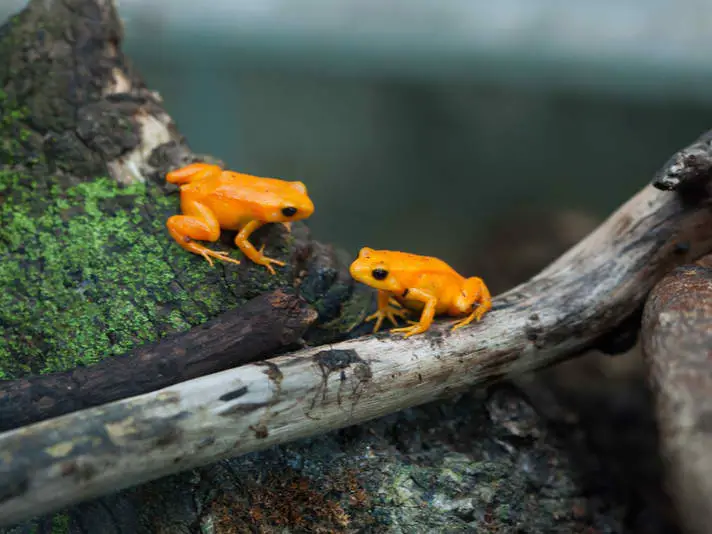
This frog is a bright yellow poisonous frog that lives in Madagascar. It lays the eggs on the land, particularly underneath the leafy litters beside a body of water. The male species does not croak to entice the females. Instead, they emit clicks that help them attract females.
This frog is yellow, red, or orange in color and measures 20 to 26 millimeters. Its inner leg shows reddish flash marks. Its tympanum is small but visible. Its bright-colored skin is a warning for predators regarding its toxicity.
#7. Lemur Leaf Frog
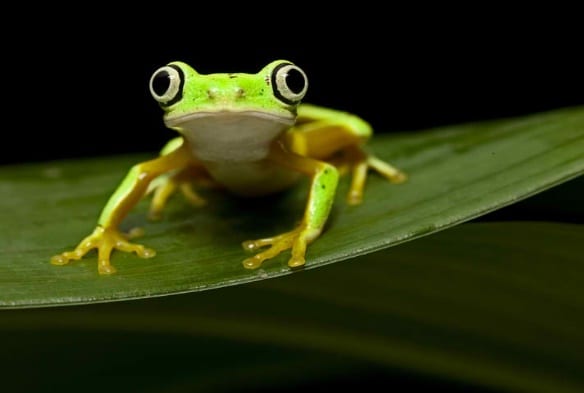
Due to the enormous loss of habitat and the impact of the chytrid fungus, the range of lemur leaf frogs and its population decreased by more than 80% throughout the past few years. The adult lemur leaf frogs are often just 3-4 cm long as it can fit on the tip of your finger.
The lemur leaf frog, also known as lemur frog, is the frog species from the family Phyllomedusidae. It exists in Panama, Costa Rica, and northwestern Colombia. The animal has been classified as critically endangered. The biggest threat to this animal is the fungal disease called chytridiomycosis.
#8. Chiricahua Leopard Frog
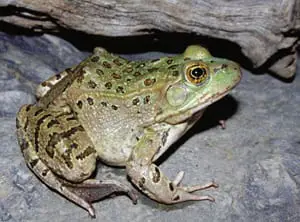
The Chiricahua Leopard Frog is also an endangered species that could be found in the cattle ponds, streams, and other wetlands. This frog is native to the US, particularly in New Mexico and Arizona, and in Mexico. The natural habitat of this frog is a river, temperate forest, swamp, intermittent river, freshwater lake, freshwater marshes, springs, ponds, or open excavation. The biggest threats to Chiricahua leopard frog are chytrid fungus and loss of habitat.
#9. Ozark Hellbender
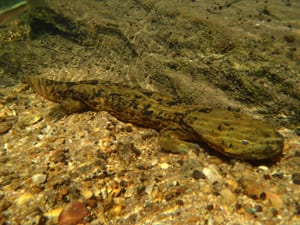
This species is considered federally endangered. It is a big salamander that lives in cool and clear spring-fed streams, underneath the big rocks and in the crevices. Drastic declines took place in the number of Ozark hellbenders since the 1970s. Experts still work to understand the reasons for the decrease in the number of salamanders.
The Ozark hellbender is a big aquatic salamander that exists in southern Missouri up to Northern Arkansas. The adult salamander can grow to 2 feet long. Its body look flattened, so it can move easily even in the fast-flowing stream. Also, this hellbender has a big keeled tail and small eyes.
#10. Crawfish frog
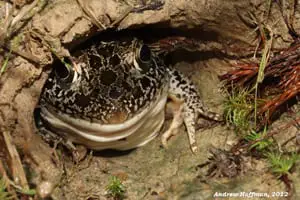
While not nationally threatened or endangered, this particular species is prone to a drastic decrease in the population because of habitat alterations and loss. This species needs the combination of transient breeding wetlands, grassland habitats, and crayfish burrows that reduce the location and number of the re-establishment sites.
The crawfish frog is the medium-sized frog that is native to grasslands and prairies in the central United States. The animal got that name because it loves to stay in the burrows made by crawfish, which they do for the most part of the year. The crawfish frog has defined black or golden circles across its body.
#11. Columbia Spotted Frog

This spotted frog lives in the spring seep, marshes, meadows, streams, ponds, and some other areas that are rich in vegetation. The biggest known threat to Columbia spotted frog is loss and alteration of the habitat, particularly the loss of the wetlands used for breeding, feeding, migrating, and hibernating.
#12. Corroboree Frogs
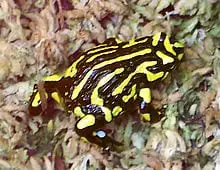
The small yellow and black Corroboree frog lives in the small sub-alpine regions of Australia. Their population decreased mainly because of the nasty fungal disease. However, in the past few years, zoos have been breeding this species and return them to the forest in the disease-free areas. Australia saw the loss of 6 frog species in the past few decades. With zoos, the Corroboree frogs stay safe from extinction.

